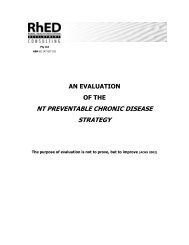DHF Annual Report 2009 - NT Health Digital Library - Northern ...
DHF Annual Report 2009 - NT Health Digital Library - Northern ...
DHF Annual Report 2009 - NT Health Digital Library - Northern ...
Create successful ePaper yourself
Turn your PDF publications into a flip-book with our unique Google optimized e-Paper software.
Performance Measure2008-09Actual<strong>2009</strong>-10Estimate<strong>2009</strong>-10Actual2010-11EstimateQuantityIndividuals receiving community-based public 5 020 4 900 5 544 5 150mental health services 1Individuals under 18 years of age receiving 911 900 1 047 1 000services 1community-based public mental healthNon-weighted occupied bed days by11 631 10 900 10 877 12 400designated services 2Non-weighted inpatient separations from 1 042 1 020 940 1 140designated services 2Mental health budget allocated to nongovernment14% 12% 14% 14%organisations 3QualityPublic mental health services accredited 4 100% 100% 100% 100%Post-discharge community mental healthN/A 20% 14% 30%care 528 day mental health readmissions 6 11% 10% 9% 11%1 Community-based public mental health services include all mental health services provided by Government(excluding government-funded non-government organisations) dedicated to the assessment, treatment,rehabilitation or care of non-admitted patients. Since 2007-08 there has been an increase of 16% in numbers ofall individuals presenting for service. To manage demand there has been an increased reliance on consultation/liaison services rather than direct service delivery especially in rural/remote localities. Persons aged less than18 years provided service in <strong>2009</strong>-10 increased by 13.5% compared to 2008-09. New demand continues at highlevels in both the Top End and Central Australia and it is likely that the 2010/11 forecast will be exceeded.2 Measure refers to inpatient services provided within two approved treatment facilities (Darwin and Alice SpringsMental <strong>Health</strong> Inpatient Units), declared pursuant to section 20 of the Mental <strong>Health</strong> and Related ServicesAct 1998. Ongoing efforts to manage high occupancy levels (to 100% or lower) continue to result in generallymore manageable levels of throughput activity. Sub-acute mental health care beds provided by the NGO sectorare also having a positive impact on this in Darwin. The growth in non-weighted occupied bed days and non-secure care initiative in both Darwin (5 beds) and Alice Springs (6 beds).3 This measure indicates the proportion of the mental health budget invested in the non-government sector fordelivery of services and support to consumers of mental health services and their carers. The <strong>NT</strong> proportion ofNGO funding continues to exceed the national average on a per capita basis. It is expected that the proportion ofNGO funds compared to total direct care mental health expenditure may decrease slightly over the next year dueto new specialist clinical initiatives being implemented.4 Mental health services accredited against relevant industry standards of best practice (National Standards forMental <strong>Health</strong> Services).5 New measure commenced from 2008-09: indicates the proportion of separations from mental health inpatientunit(s) for which a community service contact was recorded in the seven days immediately following discharge.follow-up rates for people in Darwin and other regional centres as a result of implementation of the newMental <strong>Health</strong> Triage and response Service announced in the Budget. Remote clients, who comprise 30% ofadmissions, are followed-up on discharge by remote health centres (activity that is not included in this indicator),and by specialist mental health staff on thier next visit, generally outside the 7 day period.6 New measure commenced from 2008-09: indicates the percentage of separations from the mental healthservices’ acute mental health inpatient units which results in unplanned readmission to the same or to anotherpublic acute mental health inpatient unit within 28 days of discharge. Inpatient units in both Alice Springs andDarwin were able to maintain a relatively low rate of readmission, well within the prevailing national rate.Department <strong>Health</strong> and Families 139
















